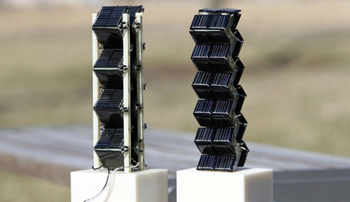MIT Researchers Experiment With 3-D Solar Panel Design
 CAMBRIDGE, Mass. — When people think of solar panels they typically envision the panels installed horizontally on a roof or perhaps even in large field — but now MIT researchers may change the way people perceive solar installation.
CAMBRIDGE, Mass. — When people think of solar panels they typically envision the panels installed horizontally on a roof or perhaps even in large field — but now MIT researchers may change the way people perceive solar installation.
MIT researchers have found that installing solar panels vertically on three-dimensional cubes of towers could improve the output and intended purpose of a solar array. However, the 3-D arrangements of solar cells aren’t entirely new — but MIT researchers say they are “the first to approach the problem with a systematic and predictive analysis.”
The researchers tested power output ranging from double to more than 20 times that of fixed flat panels with the same base area. The researchers also tested the solar panels on the roof of MIT’s Building 13 for several weeks and found that even on a cloudy day, the vertical modules outperformed the horizontal panels. Jeffrey Grossman, an associate professor of materials science and engineering at MIT, published his findings of the vertical solar arrays in the journal, Energy and Environmental Science.
One thing that might be stopping some from adopting a 3-D solar panel design may be the cost. Although MIT researchers weren’t specific they did say the cost of energy generated using their design exceeds that of ordinary flat panels. Researchers also said in a statement that despite the cost, the expense could be balanced somewhat by factors such as a much higher energy output for a given footprint and more uniform power output over the course of a day, seasons of the year and “in the face of blockage from clouds or shadows.”
Some companies may not want to invest just yet — but MIT researchers say they may have a solution for those who can’t seem to write-off the traditional horizontal panels just yet.
Researchers say the next step is to study how the two solar panel systems can work together. They gave examples including installing one solar tower in a parking lot to power a charging station for electric vehicles, and a group of towers could possibly be used in larger-scale applications, such as solar farms, with a fraction of the footprint of those being built today, once potential development issues are addressed, according to MIT.
“I think this concept could become an important part of the future of photovoltaics,” said Grossman in a statement.
